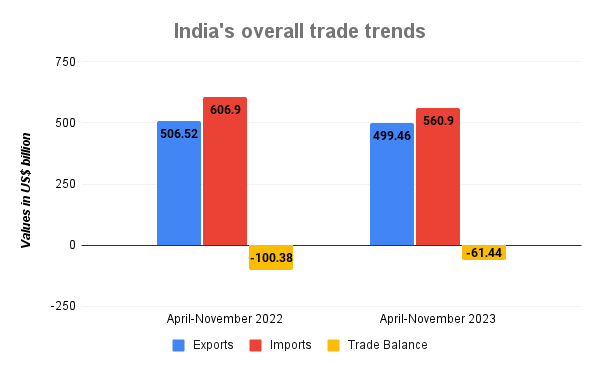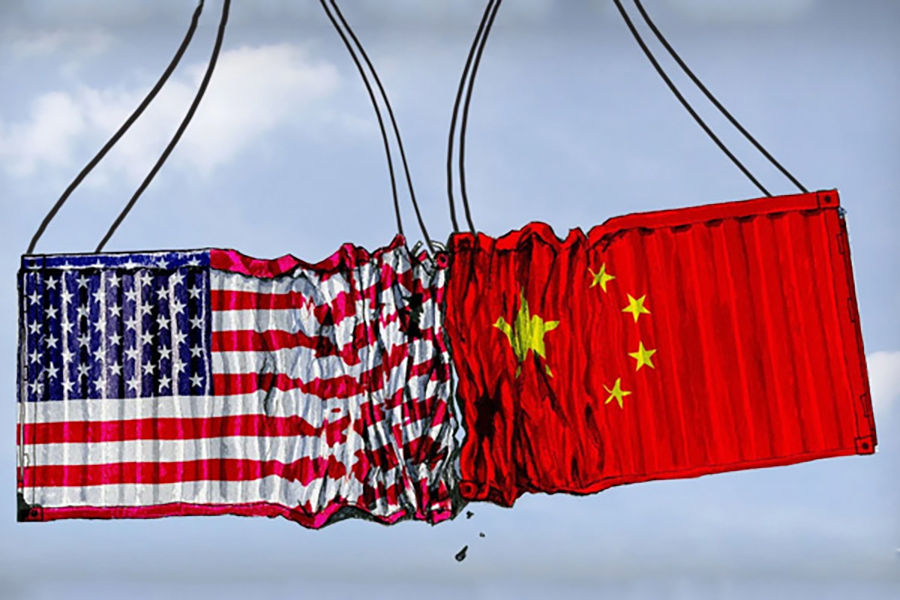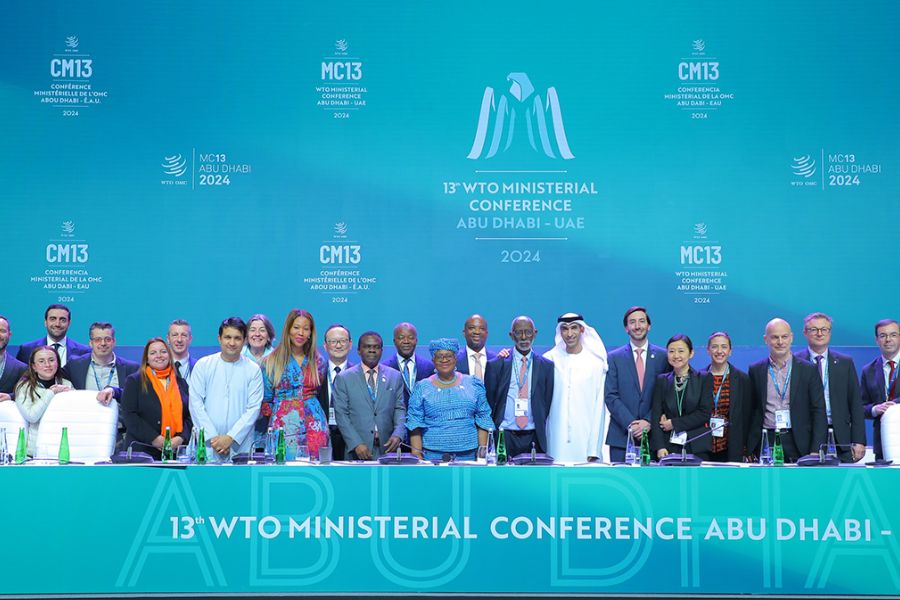India Trade Review 2023: Preparing for the long haul?
The global economic landscape is marked by a decline in world trade, as indicated by the World Trade Organization’s forecast of slowing trade growth in 2023 due to multiple global economic slowdowns. This challenging environment is mirrored in India, where India’s exporters face challenges, with a slowdown anticipated globally due to inflation and tight finances. Additionally, Deloitte’s economic outlook also emphasises the importance of boosting domestic demand in India amid global uncertainty.
The year 2023 was also pivotal given the announcement of the Foreign Trade Policy 2023 by the Department of Commerce. Through emphasis on e-commerce exports and district export action plans, India is looking to have more broad-based and sustainable growth in exports in the long term.

Source: Shutterstock
The World Trade Organisation (WTO) cut its forecast for global trade growth in 2023 in half, from 1.7% in April 2023 to 0.8% in October, citing the “abrupt” slowdown in global output and trade that continued into this year’s fourth quarter. The situation is challenging for Indian exporters looking for a bounce-back, but the 3.3% growth projection for 2024 promises hope.
UNCTAD’s trade outlook also admits that this has been a challenging year for goods trade, which is estimated to decline by 8% ($2 trillion). Geopolitical tensions, high interest rates, lower demand in developed economies, weakening industrial output, commodity price volatility, lengthening supply chains, increased subsidies, and a rise in trade restrictive measures continue to threaten a robust recovery. The inflation rate is expected to continue to vary significantly across economies, presenting a very volatile scenario next year as well.
Shipping prices have begun to slowly rise after a year-long slump, despite the persistence of drone strikes on ships in the Red Sea. Manufacturers, oil refiners, and logistics firms may be in difficult times even if the crisis might have a knock-on impact and increase the cost of goods due to potential delays.
According to the IMF, global GDP growth is expected to slow to 2.9% in 2024, slightly lower than its 2023 estimate. Central banks estimate that the impact of high interest rates will continue to hurt major economies like the US and EU, thereby exerting downward pressure on India’s merchandise exports.
While our GDP has shown resilience on domestic drivers, India’s overall exports have mirrored the global trade decline, falling by 1.39% YoY during Apr-Nov 2023 to US$ 499.46 billion. Overall imports in Apr-Nov 2023 are estimated at US$ 560.90 billion, dropping by 7.58% YoY. The global slowdown, high interest rates, and reduced discretionary spending are cited as major reasons for the decline in exports. Lower petroleum prices also contributed to the decrease in exports.
The overall trade deficit for Apr-Nov 2023 was estimated at US$ 61.44 billion, registering a decline of 38.8% YoY. The merchandise trade deficit, at US$ 166.35 billion, registered a decline of 12.08% YoY.

Source: PIB
India’s goods exports stood at US$ 278.8 billion during this period, marking a 6.51% decline YoY. But services exports in Apr-Nov 2023 were estimated at US$ 220.7 billion, at a growth rate of 5.9% YoY. Growth in service exports can be attributed to sectors such as IT services, software development, consulting, and professional services, which showcased resilience despite global economic challenges.
Within the merchandise exports category, 14 out of 30 major sectors showed positive YoY growth in April-November 2023.
| Major sectors witnessing positive growth | ||
| Iron Ore (203.93%) | Oil Meals (34.33%) | Electronic Goods (23.56%) |
| Ceramic Products & Glassware (20.9%) | Fruits & Vegetables (15.1%) | Tobacco (10.44%) |
| Oil Seeds (9.56%) | Drugs & Pharmaceuticals (8.05%) | Meat, Dairy & Poultry Products (6.31%) |
| Cereal Preparations & Miscellaneous Processed Items (6.27%) | Cotton Yarn/Fabs./Made-Ups, Handloom Products, Etc. (5.72%) | Coffee (4.72%) |
| Spices (3.34%) | Cashew (0.3%) | |
Source: Ministry of Commerce & Industry, data for April-November, 2023
Challenges for Indian exporters
- Global slowdown impact: India’s goods exports faced a sixth consecutive monthly decline, influenced by falling oil prices. Countries in the world are facing a slowdown, and global trade is relatively weak at present.
- Regulatory and tariff challenges: Non-transparent and unpredictable regulatory and tariff policies when engaging in business with other countries remain a perennial challenge.
- Supply chain disruptions: Countries around the globe are moving towards protectionist trade policies due to disrupted global political order (Russia-Ukraine War and Israel-Palestine) and weaponisation of the supply chain (drone attacks on Indian ships), which is in turn shrinking export capacities.
- Fall in commodity prices and freight rates: Export and import figures have been trending downward, mainly due to a fall in commodity prices and freight rates compared to the previous year.
- CBAM: The carbon border adjustment mechanism, also known as the carbon tax, is anticipated to impact US$ 8-9 billion in exports of iron, steel, and aluminium by India to Europe and the United Kingdom in the coming years.
India’s export policies
On the other hand, the year was memorable for the launch of the Foreign Trade Policy 2023 with a vision for US$ 2 trillion in exports by 2030. The key approach to the policy, as described by the government, is based on four pillars: incentives to remission, export promotion through collaboration-exporters, states, districts, and Indian missions, ease of doing business in transaction cost and e-initiatives, particularly given the emphasis on cross-border e-commerce and promoting exports from districts and streamlining the SCOMET policy. This should help broaden India’s export base across regions and particularly benefit MSMEs.
India has notified the Scheme for Remission of Duties and Taxes on Exported Products (RoDTEP) and Remission of State and Central Taxes and Levies (RoSCTL) to remit taxes paid on exported goods. This aligns with the global principle of not exporting taxes and aligns with India’s WTO commitments. RoDTEP provides rebates for hidden duties, taxes, and levies on goods exported. The government will continue the Advance Authorisation/DFIA scheme for duty-free input/raw material and the EPCG scheme for technological upgradation.
The Foreign Trade Policy (FTP) permits international trade settlement in INR and has made necessary changes for export benefits and fulfilling Export Obligation (EO) for domestic currency exports, as per RBI guidelines. India is willing to trade in rupees with countries experiencing currency failure or dollar shortages.
FTP 2023 aims to make India a leading merchanting trade hub by introducing a provision to allow the trade of restricted and prohibited items. This provision reduces transaction costs for smaller firms, which play a significant role in India’s goods exports, by allowing goods to be shipped without touching Indian shores and involving Indian intermediaries.
India’s foreign trade policy aims to establish partnerships with state governments and identify potential export products and services in all districts. The State Export Promotion Committee and District Export Promotion Committee will identify export-worthy products and services. District Export Action Plans (DEAPs) will be prepared for each district, providing a roadmap for promoting these products and services. The policy has no end date and will be periodically updated as needed unlike the 5 years FTP before.
However, the industry eagerly awaits policy direction on the DESH Bill, which is crucial to India mirroring China’s success in building robust industrial infrastructure and emerging as a manufacturing superpower. India needs to craft its policy with care and skill and reshape its export promotion scheme as per WTO compatibility. In addition, it is important to achieve swift closure of trade deals being negotiated. It is expected that India will be able to close three trade deals before the 2024 General Elections – India-Oman Comprehensive Economic Partnership Agreement, the European Free Trade Association with the four-nation bloc of Iceland, Liechtenstein, Norway, and Switzerland and the India-UK FTA
Accelerating India’s E-Commerce exports
The government is strongly backing e-commerce exports as a possible game changer for India’s foreign trade. Additional Secretary and DGFT Director General Santosh Kumar Sarangi, opined that there is enormous potential in Indian e-commerce exports, which is backed by huge product diversity, product innovation, and the ability of Indian entrepreneurs. He highlighted that “India’s cross-border e-commerce exports will possibly reach at US$ 200 billion by 2030.”
This growth will be driven by factors such as government support, incentives, and a focus on emerging areas. The impact of e-commerce on international trade and employment is expected to be significant, with the volume of international trade increasing via e-commerce. In the long run, e-commerce exports are likely to play a critical role in India’s broader export goal of US$ 2 trillion. The e-commerce industry is expected to make a substantial difference by facilitating the growth of MSMEs, connecting Indian entrepreneurs with global markets, and contributing to the overall export target.
The Directorate General of Foreign Trade (DGFT) is taking several initiatives to promote e-commerce exports, such as operationalising DNKs (Dak Niryat Kendras), collaborating with e-commerce platforms, various government departments, the Reserve Bank of India (RBI), and releasing the “E-Commerce Exports Handbook for MSMEs” to provide detailed insights into strategies for promoting exports via e-commerce and to smooth out various issues faced by the sector.
Moreover, the Foreign Trade Policy (FTP) has increased the value limit for courier exports to Rs 10 lakh per consignment. To boost exports, FTP 2023 proposes a designated zone with a warehousing facility for easy stocking, customs clearance, and return processing. The government plans to announce a comprehensive e-commerce policy soon, based on recommendations from the working committee on e-commerce exports and inter-ministerial deliberations.
According to Anand Mirani, Director & Lead Advisor at Simplus Exim & Corporate Advisory LLP, “the landscape for micro, small, and medium enterprises (MSME’s) is promising. With the rise of digital transformation, accessibility for businesses, particularly in the realm of e-commerce, has opened up incredible opportunities. The sheer number of internet and mobile phone users, exceeding 4.5 billion, provides a vast market. Considering Indian MSMEs, transitioning from conventional physical exports to e-commerce can be a strategic approach. The challenges, such as regulatory aspects, competition, logistics, and payment complexities, are present, but the solutions are evolving”.
He further states, “Logistics, which has traditionally been complex and costly, becomes streamlined and cost-effective in the e-commerce space. Even payments, with government reforms and policies, are becoming more secure. My earnest request to SMS’s and MSME’s is to take that crucial step forward, initiating their journey. Perhaps, every day, focusing on one aspect, they can tap into the vast opportunities unfolding in the digital era”.
So while 2023 has been a difficult year for international trade, the more optimistic industry watchers would also view it as a year when India has laid a firm foundation for long-term and broad-based growth in exports. Expansion of the export basket to more MSMEs and also across districts of India definitely holds a lot of promise.













Leave a comment